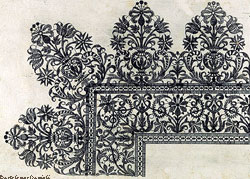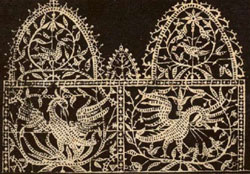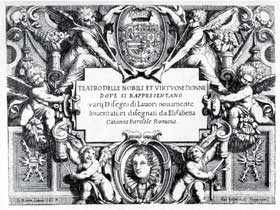
Lace Pattern Books
Pierre de Quinty
The earliest printed pattern books could be those published by Pierre de Quinty ( a French protestant) in 1527 in Koln Liure noveau et subtil touchant art et scièces ("New and subtle book respecting the art and science of making embroidery, fringes, tapestries, as well as of other crafts done with the needleand")

Di Giovanni Ostaus
La Vera perfettione del disegno 1561. Venice
On 30 June 1556, a privilegio was granted to the German publisher Giovanni Ostaus to publish a book of embroidery patterns with an illustration by Salviari.
Johann Sibmacher
Johann Sibmacher was a german engraver that works in Nuremberg from 1590 to 1611. He made thousands of etching mostly lace patterns Schon neues Modelbuch(1597 ( includes 74 patterns for counted work and 31 patterns for cutwork) ISBN-13: 978-0486231860 , coat of arms : Wappenbuch (1605).
Newes Modelbuch in Kupffer gemacht.Nuremberg, 1604
Johann Schönsperger
Published in Ausburg Germany a printed pattern book : Furm und Modelbüchlein in 1523
Ein new Modelbuch. Zwickau, 22October, 1524
Ein new getruckt Model Büchli.[Augsburg], 1529
Johann Schönsperger, another Augsburg printer, was one of the most prolific producers of illustrated books of the period, but many of his woodcuts were copied from, or had been used in other printers' issues of the same texts, not the least of which were his three plagiarized editions of the Nuremberg Chronicle (Koberger, 1493).[10] He printed two editions of the Spiegel , one in 1492 (fig. VII-6) and one in 1500, but the source of his blocks is unknown.
Very few editions of the Speculum were printed in the sixteenth century, for the change in religious and intellectual climate and the rise of Humanism and Protestantism gradually undermined the popularity of the typological treatises.
We have attempted to trace the steps in the metamorphoses of the Speculum humanæ salvationis from its fourteenth-century Latin manuscripts into the gloriously illuminated French translations for ducal courts, and their models; then, with the advent of the woodcut and of movable type, its appearance in the four editions of the blockbooks; and finally, its many letterpress editions with woodblocks and text printed in the press.
Adrian Wilson, The Making of the Nuremberg Chronicle , 2nd edition, revised (Amsterdam, 1978), p. 191.
Other books published in Germany in the 16th c.
Quentel:
Eyn new kunstlich Boich. Cologne, 1527
Eyn newe kunstlich Moetdelboech. Cologne,1529
Eyn newe kunstlich Moetdelboech. Cologne,1529
Eyn newe kunstlich Moetdelboech. Cologne,1532
Ein new kunstlich Modelbuchy mit 700 Figuren. Cologne, 1544
Schwartzenberger
Ein schöns nutzlich newes Form-büchlin. Augsburg, 1534
Ain schöns nutzlich newes Form-büchlin. Augsburg, 1535.
Steyner
Ein new Modelbuch. Augsburg, 1534
Egenolff
Modelbuch aller Art Nehens vs Stickens. Frankfort am Main (1535).
Gülfferich
Modelbuch s. Frankfort a.M., 1553
Hoffmann
New Modelbuch. Strassburg, Jacob Frölich, 1556
h Jobin
New künstlichs Modelbuch. [Strassburg], 1600
Francesco di Pellegrino
Fleur de la Science de Pourtraicture et Patrons de Broderie Paris 1530 by Francesco di Pellegrino known as Francois Pellegrin
Pierre de Sainte Lucie
La fleur des patrons de lingerie à deux endroits, à point croisé, à point couché et à point piqué: Lyon 1549 Pierre de Sainte Lucie
Claude Nourry:
la fleur des patrones de lingerie, Lyon 1533
Le livre de lingerie. Paris, Hierosme de Marne & la veuve de Guillaume Cavellat, 1584
Baptiste Antheaume: Livre de meubles propres pour Mrs les brodeurs et Tapissiers, Paris 1550
de Gormont: Livre de Moresques très utile & nécessaire, Paris 1546
Matio Pagano
The most ancient of all Italian books of design could be
Il Burato (undated but probably contemporary with Colonia's work dated 1527) .
Matio Pagano book was published in venice in 1547. in Venice. Tagliente, Vavassori, Vinciolo, Vecellio, Pagano are all Venetians.
Lhonesto essempio. Venice, 1550
Giardineto novo di punti tagliati. Venice, 1554
Ornamento delle belle et virtuose donne. Ve-ice, 1554
La gloria et l'honore di ponti tagliati e fogliami.Venice, 1556
La gloria et Phonore de ponti tagliati e ponti inaere. Venice, 1558
Federico de Vinciolo
Les Singuliers et Nouveaux Pourtraicts 1587. Federico Vinciolo was an italain lace maker hired by Henry III king of France. This book was reedited several times between 1587 and 1606 and translated in English later.
PDF from The French National Library
Shorleyker
Schole-house for the Needle (1624)
The Needle's excellency London 1631
Bartolomeo Danieli
Vasi disegni di Merletti, Bologna 1639 . Bartolomeo Danieli produced several lace patterns books from 1610 to 1643.

Cesare Vecellio (1521-1601)
"Corona delle nobili et virtuose donne, libro primo-terzo nel quale si dimostra in varij disegni" Venice 1591 . Cesare Vecellio was a a painter and engraver. He probably worked with TITIAN from 1550 to 1576. As an engraver he published the first illustrated costume book, De gli habiti antichi et moderni di diverse parti del mondo (Venice, 1590). In 1591 he published a pattern book on embroidery and lace making: Corona delle nobili et virtuose donne

link: Vecellio.net created by Traci Timmons
Elisabetta Catanea Parasole (1565-1625)
She is the most famous Italian lace designer and wood engraver of her time. She published " Specchio delle virtuose donne" ( the mirror of virtuous women) in 1594 Venice . She lived in Rome and got married with Leonardo Norsini, a wood engraver.

Pretiosa gemma delle virtuose donne, Roma 1598
La corona della nobili et virtuose donne, Rome 1601
